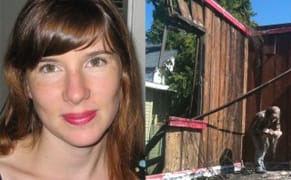"Artist, Entrepreneur, Opportunist"
Mention the name Kirsha Kaechele (assuming you can pronounce it) to folks in the New Orleans arts communities and you're likely to hear a wide range of opinions—and her story brings up a host of interesting questions regarding the complex and often conflicting mix of motivations, ego, and consequenc

Mention the name Kirsha Kaechele (assuming you can pronounce it) to folks in the New Orleans arts communities and you’re likely to hear a wide range of opinions. And whether you’re part of that community or not, her story brings up a lot of interesting questions regarding the complex and often conflicting mix of motivations, ego, and consequences behind community-based art projects and the personalities involved in creating them.
To recap: Kaechele first gained notoriety in the Crescent City with a series of exhibitions and events she organized in the fall of 2008 to coincide with the opening of the Prospect. 1 biennial exhibition. Most of these were centered around a group of derelict buildings she purchased in New Orleans’ Seventh Ward, an economically disadvantaged neighborhood not too geographically distant from the French Quarter but about as far from the genteel precincts of Royal St. and the high-end galleries of the Warehouse District as you can get. Kaechele’s projects included a $250-a-plate fundraising dinner-slash-arty block party attended by the likes of actress Uma Thurman and a collaboration with artist Mel Chin, who constructed a giant bank vault-like apparatus in the facade of one of Kaechele’s properties on Villere Street. Even more significantly, the projects garnered a massive amount of high profile publicity for Kaechele herself.

Flash forward to 2011, and Kaechele’s properties sit abandoned after she left town. In the interim, she was variously reported to be in the Bay Area working on a medical marijuana-for-arts funding project and then on a new art venture in Tasmania with her boyfriend. Meanwhile, an incendiary article in the New Orleans Times-Picayune by the paper’s art critic (who had previously been one of her most ardent supporters) basically accusing her of willful neglect of her former properties made her a persona non grata in many artistic circles in her former town — although she still maintains a circle of friends and collaborators who have come forth to defend her.
All of which is a roundabout way of introducing a new interview with Kaeschle published by the New Orleans-based The Lens last week, in which Kaeschele attempts to explain her motivations and way of doing things (“I see myself as a life artist. I work with the intersection of art, architecture and ecology.”) while making some statements that are sure to give her detractors more grist for the mill (“I spent most of my life as a minority in another culture. I grew up on Guam and was always the only white person on my block.”)
One thing’s for sure: she hasn’t lost her knack for publicity. Whether or not you’re familiar with Kaeschele or her story, it makes for a fascinating read.




